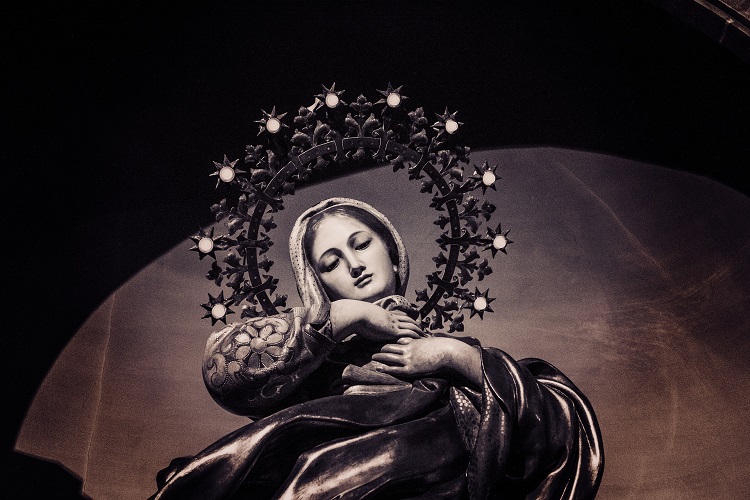Guerrero, Rizal’s biographer, did not hold a high opinion of Maria Clara.[1] Neither do countless essayists, artists, orators and ordinary citizens. Don’t we now commonly use Maria’s name as a derogatory term to describe weak, helpless women? While I do wish she was endowed with better qualities, I can’t help but empathize with her character. It must have been difficult to overcome the restraints of a deeply religious colonial society.

Chapter 36: The First Cloud
Maria Clara weeps inconsolably, having been forbidden by her father from speaking with the excommunicated Ibarra. Capita Tiago, threatened by Padre Damaso with damnation in life and in the next, announces he must break Ibarra and Maria Clara’s engagement. He tells Maria Clara she is to marry a relative of Padre Damaso from Spain.
The noise outside suggests the arrival of the Captain-General and Maria Clara flees to her room, seeking succor from the image of Mary. Aunt Isabel intrudes upon her sorrow and asks her to prepare herself to meet the Captain-General.
Chapter 37: His Excellency
At Capitan Tiago’s house, the Captain-General[2] receives the friars coldly and does not speak well of Padre Damaso. The friars are displeased. He also meets with Maria Clara, thanks her for her noble action at the gathering and assures her that justice is not blind.
In his separate meeting with Ibarra, he expresses approval over the young man’s philanthropy and love for his father. He is further pleased when he discovers that Ibarra is not a sycophant. He promises to speak with the Archbishop on Ibarra’s behalf, but advises him to be more prudent next time.
During their talk, the Captain-General reveals the burdens of his office. Despite the difficulties and imperfections of the government, he wishes to know how he can help Ibarra. The young man replies that what he desires can only be given by the government after years of toil and the introduction of reforms.
The Captain-General realizes that Ibarra’s way of thinking is different and invites him to accompany him to Europe where Ibarra will fit better, but Ibarra declines, wishing to stay in the Philippines. The Captain-General entrusts him to the alcalde’s care.
Chapter 38: The Procession
The Captain-General, accompanied by Capitan Tiago, the alcalde, the alferez and Ibarra, sets out on foot to the gobernadorcillo’s house nearby to watch the procession and listen to the loa.[3]
The procession commences with the school children bearing their handmade lanterns, followed by the poorly dressed statue of St. John the Baptist on an old wooden platform. He is followed by the figures of the saints with more devotees, and therefore more grandly adorned: St. Francis, Mary Magdalene, San Diego and the Virgin.
As the Virgin’s carro[4] passes by Capitan Tiago’s house, a pleadingly prayerful song is heard. Ibarra is terrified and saddened by what he hears and wonders if he is the cause of the singer’s sorrow.
Chapter 39: Doña Consolacion
Ashamed of his wife’s untidy and unsightly appearance, the alferez had forbidden his wife from attending mass or joining the festivities. Believing herself to be actually beautiful, Doña Consolacion takes this restriction bitterly, and shuts their house up, now the only gloomy residence in town.
The Doña hears Sisa singing nearby and has her brought up. She orders the madwoman to sing to her and to dance. Sisa is unable to understand the second order, so Doña Consolacion whips her until she begins to dance. The alferez catches the scene and has Sisa taken away and cared for, while the alferez and his wife come to violent blows over the incident.
Chapter 40: Right and Might
The townspeople gather at the plaza theater for its last show. Ibarra arrives late and sits beside Maria Clara’s friends. Padre Salvi, unable to get Don Filipo, the teniente-mayor to eject Ibarra, walks out. Some, who witnessed the scene declare their support for Ibarra despite his excommunication. Ibarra is surprised at the news of his excommunication, thinking it medieval.
Meanwhile, some civil guards arrive and create a ruckus to stop the show, as the alferez and his wife are unable to sleep. The crowd descends into disorder, and Don Filipo asks Ibarra for help to calm the crowd. Ibarra in turn spots Elias, and asks for his help.
At the convent, Padre Salvi hears the uproar, imagines Maria Clara being taken advantage of by Ibarra in the midst of the tumult, and rushes back to the plaza, but the maiden is no longer there. Thinking only of her, he pays heed to no one else despite people calling out to him.
The following day, the correspondent reports the noble deeds of Padre Salvi, and credits him for selflessly rushing out to calm and protect his flock.
Notes and References:
1. He calls her a ninny. Leon Ma. Guerrero, The First Filipino, (Manila: Guerrero Publishing, Inc., 2010), 140.
2. Guerrero’s translation uses the title Governor General. Jose Rizal, Noli Me Tangere, Translated by Leon Ma. Guerrero, (Manila: Guerrero Publishing, Inc., 2010), 261. The title is also commonly used in Philippine textbooks.
3. A metrical piece delivered in honor of someone. Jose Rizal, Noli Me Tangere, Critical Edition by Isaac Donoso Jimenez, (Quezon City: Vibal Foundation, 2011), 726.
4. A vehicle where a saint’s statue is placed to be drawn around town during a procession. These days in some towns, the carros of saints are motorized and no longer rely solely on manual pulling.
Recent Comments